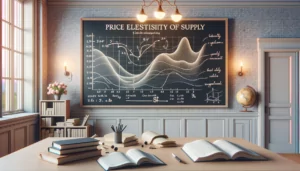Deflation, a term often discussed with caution by economists, refers to the overall decline in prices of goods and services. While this might initially seem like a bonus for consumers, the broader implications of deflation can be far-reaching and detrimental for the economy. In this article, we’ll delve into what deflation is, its causes, and its potential impacts on the economy.

✅ AI Essay Writer ✅ AI Detector ✅ Plagchecker ✅ Paraphraser
✅ Summarizer ✅ Citation Generator
What is deflation?
Deflation is described as a general decrease in prices for goods and services, usually coupled with a reduction in the supply of money and credit available in the economy. As deflation sets in, the currency’s purchasing power tends to rise, meaning that over time, a given amount of money can buy more than it previously could.
Deflation is an economic phenomenon characterized by a decline in the prices of consumer goods and services, leading to an increase in the purchasing power of money.
At a surface level, deflation might seem advantageous for consumers. After all, being able to purchase more with the same amount of money appears beneficial. However, the broader picture reveals potential pitfalls, especially when considering its impact on borrowers. Borrowers could end up repaying their debts with money that has higher purchasing power than when they borrowed it, leading to real losses. Additionally, those in the financial market, speculating on price rises, can also face adverse consequences.
Causes of deflation
Several factors can drive an economy into a deflationary state. It is crucial to understand that deflation doesn’t arise from a single cause but is often the result of a combination of economic shifts and policies. To gain a clearer understanding, let’s categorize and explore the primary contributors to this phenomenon:
| Monetary Factors | At its core, monetary deflation occurs when there’s a drop in the supply of money or financial instruments that can be redeemed for cash. Central banks, like the Federal Reserve, predominantly influence the money supply. If the supply of money and credit decreases without a corresponding reduction in economic output, prices for goods tend to drop. This scenario was evident during the early 1930s in the U.S. when bank failures led to a significant deflationary period. |
| Aggregate Demand | Another common cause is a decline in aggregate demand, meaning the total demand for goods and services decreases. Factors contributing to this decline might include reduced government spending, stock market downturns, an increase in consumer savings, or tighter monetary policies manifesting as higher interest rates. |
| Technological Advancements | Technological progress can also lead to deflationary effects, especially when productivity outpaces the money and credit supply. For instance, the massive reduction in the cost per gigabyte of data over decades, thanks to technological advancements, led to lowered prices for tech products. |
Impact of deflation
Deflation might seem like a boon for consumers on the face of it, but its domino effect on the economy can be concerning:
- Unemployment: Lower prices can lead to decreased company profits. To counteract these losses, companies might resort to cost-cutting measures, including layoffs.
- Debt Issues: Deflationary periods typically see a rise in interest rates, making debts more burdensome. This can result in decreased spending by both consumers and businesses.
- Deflationary Spiral: This represents a vicious cycle where falling prices lead to reduced production, translating to lower wages, culminating in decreased demand. This cycle further pushes prices down, worsening the economic situation.
While inflation reduces the dollar’s power, it also lessens the real value of debt, facilitating continuous borrowing and debt repayments. A modest inflation rate is usually seen as a sign of healthy economic growth. In contrast, deflation is often associated with economic recessions, and in severe cases, depressions.
Protecting oneself from the effects of deflation is challenging. With increasing debt costs during deflation, businesses and individuals are wary of borrowing. The safest bet during deflationary periods is often cash investments, even if they offer minimal returns.
Deflation has the potential to enhance a consumer’s purchasing power due to the decline in prices. However, if deflation persists for an extended period, it can result in elevated unemployment rates, pushing many consumers into defaulting on their debt commitments. Such prolonged and deep-rooted deflationary periods have historically set the stage for severe economic downturns, exemplified by events like the Great Depression.
Deflation, while offering the immediate allure of reduced prices, poses significant risks to the broader economy. Recognizing its causes and potential impacts can help policymakers and individuals make informed decisions during such economic phases. The government, with tools like fiscal policy management and control over the money supply, can play a pivotal role in curbing the adverse effects of deflation.
FAQ
Follow us on Reddit for more insights and updates.





Comments (0)
Welcome to A*Help comments!
We’re all about debate and discussion at A*Help.
We value the diverse opinions of users, so you may find points of view that you don’t agree with. And that’s cool. However, there are certain things we’re not OK with: attempts to manipulate our data in any way, for example, or the posting of discriminative, offensive, hateful, or disparaging material.